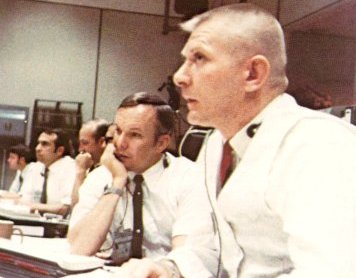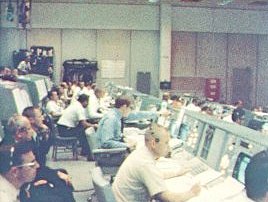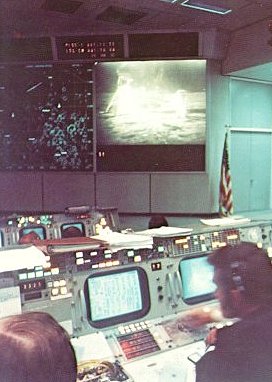Time Travel Research Center © 2005 Cetin BAL - GSM:+90 05366063183 - Turkey/Denizli
Apollo Expeditions to the Moon
CHAPTER 4
VIGILANCE AND JUDGMENT
"The accomplishments of this last Apollo mission and the successes of the
previous Apollo flights were the result of the dedicated efforts and the
sacrifices of thousands of individuals." I have difficulty recollecting how
many times I stood on the platform at Ellington Air Force Base welcoming the
returning flight crews and heard those words repeated. But they are
nevertheless quite true. The people in Houston were with their astronauts
each step of the way. The interchange between Mike Collins, serving as the
CapCom (capsule communicator), and Bill Anders as Apollo 8 orbited the Moon
clearly demonstrated this feeling. Mike called Apollo 8, saying "Milt says
we are in a period of relaxed vigilance". Bill came back with "Very good. We
relax; you be vigilant." They came to rely on the controllers, as they well
knew their very lives depended on their vigilance and judgment. Mike later
put it well in his book, Carrying the Fire. He writes of the Gemini 10
reentry and their reliance on "Super Retro" John Llewellyn. Mike says that
they knew if they made a mistake John would be so angry that he would stick
up his strong Welsh arm and yank them out of the sky. John's dominant
personality is illustrated by the time he was coming on duty for his shift
in the Control Center and, finding his parking space taken, he simply parked
on the walk next to the door rather than waste time looking. Like his
compatriots, John was thoroughly dedicated. His type is at its best when
fighting wars or flying missions.
Many individuals were involved in the building and testing of the spacecraft
and its systems, but once given the spacecraft and the necessary facilities
and equipment, the Apollo Operations Team was charged with the awesome
responsibility for the accomplishment of the mission. This team was composed
of hundreds of individuals - government and contractor personnel, as well as
representatives of the Department of Defense and of foreign nations such as
Australia and Spain. Each team member had been carefully selected and
subjected to countless hours of training and simulations; each had also
participated in Mercury, Gemini, or Apollo testing and flight operations.
Time and time again, these young men had to rely on their technical
knowledge to assess the unexpected and determine the right course of action.
The "luck" the Operations Team had in overcoming adversity is exemplified by
the words of University of Texas football coach Darrell Royal: "Luck is what
happens when preparation meets with opportunity". The luck of the Operations
Team was the result of thorough and careful planning and training and the
development of both people and procedures.
| Mission Control candid photography by Andrew R. Patnesky |
 |
| Flight Director Gene Kranz watches his console display tensely as the Apollo 11 lunar module Eagle slowly settles down with its descent engine fuel supply all but exhausted. Gerry Griffin, a Flight Director during other phases of the mission, looks on in complete absorption. |
 |
As the Apollo 11 lunar module begins the descent toward its historic touchdown, off-duty Operations Team members watch unobtrusively from a few extra chairs in the Mission Operations Control Room. |
 |
A television monitor at the front of the Mission Operations Control Room displays real-time images of Astronauts Armstrong and Aldrin at work on the Moon. |
Thinking back over the events of the past years, I realize the Operations
Team was always prepared when the opportunity presented itself. I'll
certainly always remember their performance on Apollo 11. It takes an awful
lot of events all going right to get you to the Moon, let alone return. It
was our first attempt at the landing and we had somehow, incredibly, reached
the point where we were starting the descent for the landing. Thus far, all
had gone astonishingly well. The first phase of the firing of the lunar
module engine went well as the descent started; and then, approximately five
minutes after ignition, the first of a series of computer alarms was
received via telemetry in the Mission Control Center and was also displayed
to the crew onboard the lunar module Eagle. I was responsible for the
software in that computer, the logic that made it all work. You can imagine
the thoughts racing through my mind: Had we come all this way for naught?
What was wrong? The flight controller responsible for assessing the problem,
27-year-old Steve Bales, was faced with an immediate decision: Should we
continue the descent or initiate an abort? An abort meant there would be no
landing for Apollo 11: we would have to try again. When Flight Director Gene
Kranz pressed him for his answer, young Mr. Bales' response was the loudest
and most emphatic "go" I have ever heard.
But it wasn't over yet. The lunar module was under automatic control as it
approached the surface. Neil realized that the automatic descent would
terminate in a boulder field surrounding a large rim crater. He took over
control of the spacecraft and steered the Eagle toward a smooth landing
site. The low-level fuel light for the engine came on, indicating about
enough fuel for only 116 seconds of firing time on the engine. With 45
seconds of fuel left, Eagle set down with a jolt and we were there.
Lunar Roving Vehicle. The Lunar Roving Vehicle was used for the first time with great success on the Apollo 15 mission. Figure 5 shows the vehicle beside the Lunar Module. The lunar payload capacity was several times the vehicle's Earth weight. The vehicle propulsion system was battery operated, each wheel of the vehicle being individually driven by a one-quarter horsepower electric motor. The operational life was 72 hours during the lunar day, enough to easily provide a 9.65 km (6 mile) exploration radius. It was transported to the moon folded tightly into a storage quadrant of the Lunar Module and was deployed by pulling two nylon operating tapes and removing release pins. The Rover was then unfolded for use.

Figure 5. Apollo 16 Lunar Module and Lunar Roving Vehicle.